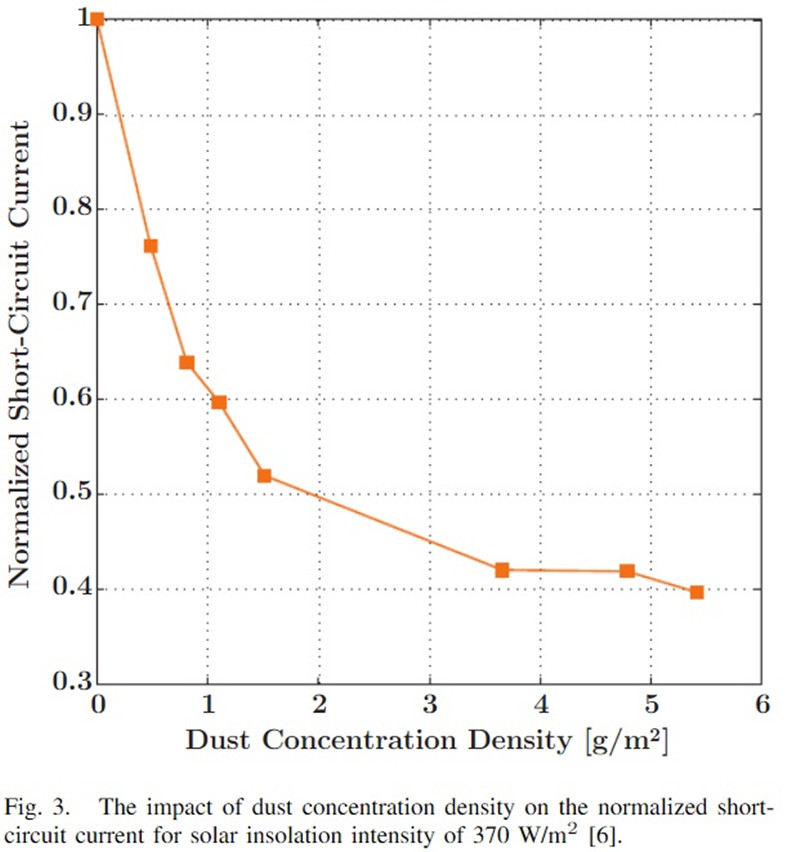Water conservation is a key issue for CSP operators looking to minimize operating costs, particularly those situated in remote desert areas. Much of the world’s CSP capacity is being installed in desert or arid regions since these areas provide some of the highest levels of direct normal irradiance (DNI). These plants require large amounts of water to be sourced on a regular basis to clean parabolic trough or heliostat mirrors.
To take one example, the 100 MW Shams 1 parabolic trough plant in Abu Dhabi consumes five million gallons of water per year for cleaning, due to the desert environment and high concentration of aerosols. In the Arabian Gulf, dust can register humidity levels of 90% and forms a firm layer which cannot be removed solely via air pressure.
Frequent mirror cleaning is vital to ensure efficient plant operations. As the below table shows, early stage dust accumulation can have a significant impact on performance.
Impact of dust accumulation on circuit current
A number of research groups are now developing new technologies to optimize cleaning strategies and minimize water consumption, improving the competitiveness of CSP plants.
French energy research center CEA is leading a European research project to develop new water management technologies for power block cooling and cleaning of solar field surfaces. Launched in early 2016, the three-year WASCOP project is being funded under the European Union’s Horizon 2020 support program.
The WASCOP researchers aim to reduce water consumption of CSP plants by 70% to 90% and boost power output by 2 to 3%. Project teams are testing a number of anti-soiling, advanced cleaning and plant monitoring technologies at multiple sites in Europe, North Africa and the Middle East.
“The preliminary results in WASCOP are demonstrating compliance with the first target: a 70% reduction in water consumption,” Itziar Azpitarte, Marketing Director at Spanish technological center IK4-Tekniker, a WASCOP partner, told New Energy Update.
Tests at Kuwait’s Shagaya CSP plant have shown WASCOP’s technologies can reduce cleaning frequency by almost 65%, Azpitarte noted.
The 50 MW Shagaya plant, scheduled to come online in December 2017, is currently expected to use 40,000 cubic meters of water per year. WASCOP’s solutions could lower this to 14,000 cubic meters/year, resulting in opex savings of around 100,000 euros/year ($117,000/year), Azpitarte said.
Data-driven
In parallel, the MinWaterCSP research group is developing new technologies to optimize cleaning processes and minimize water use.
The three-year MinWaterCSP project is also receiving funding under the EU Horizon 2020 program and current projects include the development of new soiling measurement devices.
MinWaterCSP partner Fraunhofer ISE (Germany) and commercial partner Process Systems Enterprise (PSE) are working with mirror-maintenance specialists ECILIMP Termosolar to integrate a fully automated soiling reader into ECILIMP’s cleaning systems.
The pFlex portable reflectometer measures soiling on parabolic trough fields, heliostats and linear Fresnel collectors and is operated via a smartphone user interface.
The WACSOP researchers have also developed a system of sensors for CSP mirror surfaces which identify when mirrors and CSP tubes must be washed. The system correlates data on mirror reflectance, soiling rate, and receiver transmittance to determine required actions.
The sensor system optimizes cleaning schedules and minimize optical loss in the solar fields. The devices could cut water consumption by up to 25%, Azpitarte said.
Across the energy sector, operators are implementing advanced real-time data monitoring and data analytics technologies to improve competitiveness. From PV plants through to nuclear power stations, operators are using the power of big data to predict faults and optimize operations and maintenance (O&M) activities.
Water recovery
Another team in the WASCOP research group is developing a mirror cleaning system using dew water that condenses on surfaces in the morning hours.
The “cleaning lip system” collects dew water and uses gravity to move along the mirror. According to the developers, it can keep mirrors clean without requiring additional water supplies.
Further improvements in water recovery will help to raise plant efficiency. The CSP generation process produces large amounts of waste water and most cleaning systems in operational CSP plants do not retain the sprayed water for reuse. Water that leaks away into the soil could be collected and treated for reuse.
At Morocco’s Noor 1 facility for instance, the operator uses more than 36.5 million litres of demineralized water per year to wash mirrors, without recovery, according to the Al Akhawayn study.
Similarly, wastewater from Shams 1’s cleaning process is not currently recovered as it contains dust and organic contaminants. The UAE’s Masdar Institute is therefore developing a membrane system to filter the fine dust and degrade the contaminants.
Improvements can also be made to cleaning vehicles and equipment. The Shams Power company is currently investigating a modification to the cleaning trucks for Shams 1 to make them more efficient and reduce water consumption.
At the same time, MinWaterCSP researchers have developed a system for cleaning trucks which recycles run-off water from mirrors. Parts of this system will be implemented in two major commercial CSP projects, a research partner told New Energy Update.
